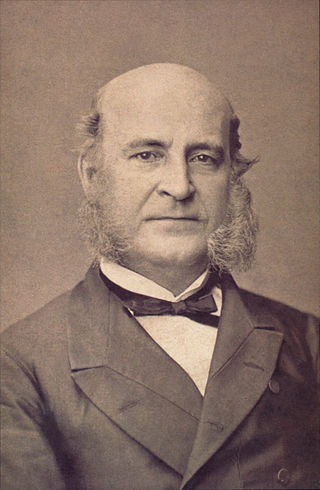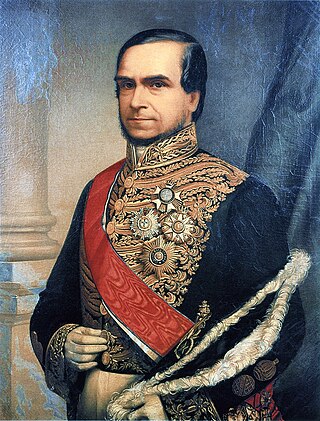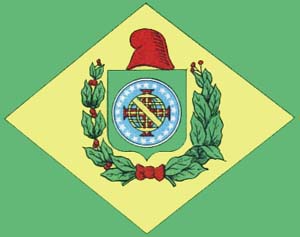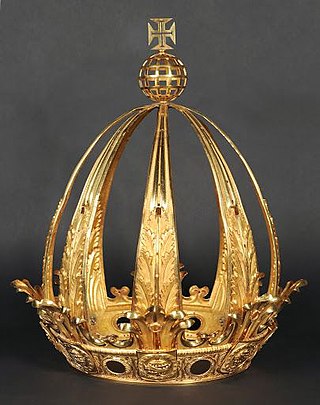
The Empire of Brazil was a 19th-century state that broadly comprised the territories which form modern Brazil and Uruguay. Its government was a representative parliamentary constitutional monarchy under the rule of Emperors Pedro I and his son Pedro II. A colony of the Kingdom of Portugal, Brazil became the seat of the Portuguese Empire in 1808, when the Portuguese Prince regent, later King Dom John VI, fled from Napoleon's invasion of Portugal and established himself and his government in the Brazilian city of Rio de Janeiro. John VI later returned to Portugal, leaving his eldest son and heir-apparent, Pedro, to rule the Kingdom of Brazil as regent. On 7 September 1822, Pedro declared the independence of Brazil and, after waging a successful war against his father's kingdom, was acclaimed on 12 October as Pedro I, the first Emperor of Brazil. The new country was huge, sparsely populated and ethnically diverse.

Luís Alves de Lima e Silva, Duke of Caxias, nicknamed "the Peacemaker" and "the Iron Duke", was an army officer, politician and monarchist of the Empire of Brazil. Like his father and uncles, Caxias pursued a military career. In 1823 he fought as a young officer in the Brazilian War for Independence against Portugal, then spent three years in Brazil's southernmost province, Cisplatina, as the government unsuccessfully resisted that province's secession in the Cisplatine War. Though his own father and uncles renounced Emperor Dom Pedro I during the protests of 1831, Caxias remained loyal. Pedro I abdicated in favor of his young son Dom Pedro II, whom Caxias instructed in swordsmanship and horsemanship and eventually befriended.

Cândido José de Araújo Viana, Marquis of Sapucaí was a Brazilian politician and judge.

José Maria da Silva Paranhos, Viscount of Rio Branco, was a Brazilian politician, monarchist, diplomat, teacher and journalist. Rio Branco was born in Salvador, in what was then the Captaincy of Bahia, to a wealthy family, but most of the fortune was lost after his parents' deaths early in his childhood. In 1871, Rio Branco became the president of the Council of Ministers for the first time. He would become the Council's longest-serving president, and his cabinet the second longest, in Brazilian history. His government was marked by a time of economic prosperity and the enactment of several reforms. The most important of these initiatives was the Law of Free Birth, which granted freeborn status to children born to slave women. Rio Branco led the government that enacted this law, and its passage increased his popularity. His government was plagued by a long crisis with the Catholic Church that resulted from the expulsion of Freemasons from its lay brotherhoods. After more than four years heading the Cabinet, Rio Branco resigned in 1875. Following a long vacation in Europe, his health swiftly declined and he was diagnosed with oral cancer. Rio Branco died in 1880 and was widely mourned throughout the country. He is regarded by most historians as one of Brazil's greatest statesmen.

Rodrigo Augusto da Silva, nicknamed "the diplomat", was a politician, diplomat, lawyer, monarchist and journalist of the Empire of Brazil. He is best known as the minister that authored and countersigned with Princess Isabel, then Princess Imperial Regent the law that ended slavery in Brazil. Rodrigo was born in São Paulo into a family of wealthy financiers. His father, the Baron of Tietê, was also a politician and leader of the conservative party in São Paulo.

The siege of Paysandú began on 3 December 1864, during the Uruguayan War, when Brazilian forces and Colorado forces attempted to capture the city of Paysandú in Uruguay from its Uruguayan Army defenders. The siege ended on 2 January 1865, when the Brazilian and Colorado forces conquered the town.

Honório Hermeto Carneiro Leão, Marquis of Paraná was a Brazilian politician, diplomat, judge and monarchist. Paraná was born to a family of humble means in São Carlos do Jacuí, in what was then the captaincy of Minas Gerais. After attending the University of Coimbra in Portugal and having returned to Brazil, Paraná was appointed a judge in 1826 and later elevated to appellate court justice. In 1830, he was elected to represent Minas Gerais in the Chamber of Deputies; he was re-elected in 1834 and 1838, and held the post until 1841.

Pedro de Araújo Lima, Marquis of Olinda was a politician and monarchist of the Empire of Brazil. His long political career spanned the reigns of John VI, Pedro I and Pedro II. He was also one of the founders of the Brazilian Conservative Party.
Conservatism in Brazil designates the movement originated from certain cultural traditions of Brazil, as well as the relationship with Portuguese-Iberian cultural roots and diverse influences. The movement received influences from Roman heritage and part of Greek philosophy in its foundation in Christianity.

Joaquim José Inácio, Viscount of Inhaúma, was a naval officer, politician and monarchist of the Empire of Brazil. He was born in the Kingdom of Portugal, and his family moved to Brazil two years later. After Brazilian independence in 1822, Inhaúma enlisted in the Brazilian navy. Early in his career during the latter half of the 1820s, he participated in the subduing of secessionist rebellions: first the Confederation of the Equator, and then the Cisplatine War, which precipitated a long international armed conflict with the United Provinces of the Río de la Plata.
The 1868 Brazilian political crisis led to the resignation of the ruling Progressive cabinet and the return of the Conservative Party to power in the Empire of Brazil.

The Liberal Rebellions of 1842 were a series of rebellions that took place in the Brazilian provinces of Minas Gerais and São Paulo in response to actions taken by emperor Dom Pedro II to unify power under the central government and limit the powers of the provinces. These rebellions were poorly coordinated and were put down by the central government to little effect. Along with the rebellions in Rio Grande do Sul, the Liberal Rebellions marked the end of a series of province-level rebellions that threatened the Empire of Brazil's stability.

The Imperial Brazilian Army was the name given to the land force of the Empire of Brazil. The Brazilian Army was formed after the independence of the country from Portugal in 1822 and reformed in 1889, after the republican coup d'état that created the First Brazilian Republic, a dictatorship headed by the army.

Eusébio de Queirós Coutinho Matoso da Câmara was a Brazilian magistrate and politician, Minister of Justice (1848–1852) and author of one of the most important laws of the Empire of Brazil, the Eusébio de Queirós Law, which suppressed the slave trade and paved the way for its eventual eradication. He was also responsible for the Commercial Code of 1850 that still remains partly in force today.

The Liberal Party was a Brazilian political party of the imperial period, which was formed c. 1831 and ended with the proclamation of the Republic in 1889.

The crown of Pedro I is the first imperial crown of Brazil and was made for emperor Pedro I of Brazil. It was made in 1822 for his coronation and was the symbol and emblem of Brazilian imperial power until it was replaced in 1841 by the crown of his son and successor Pedro II. It is one of the jewels of the Brazilian Empire and is now on display at the Imperial Museum in Petrópolis.















